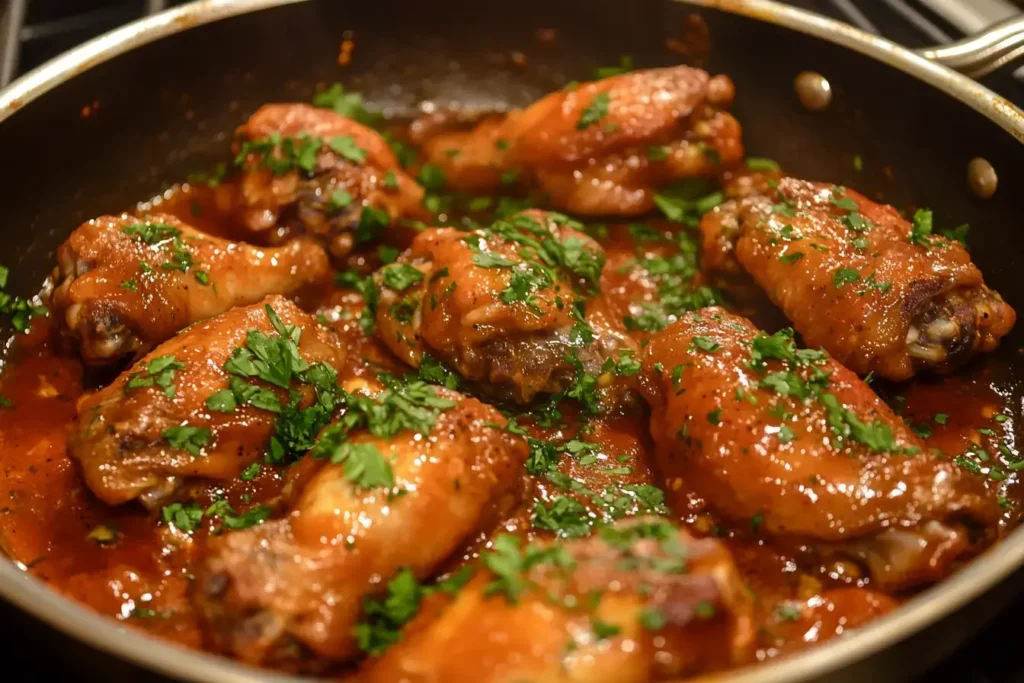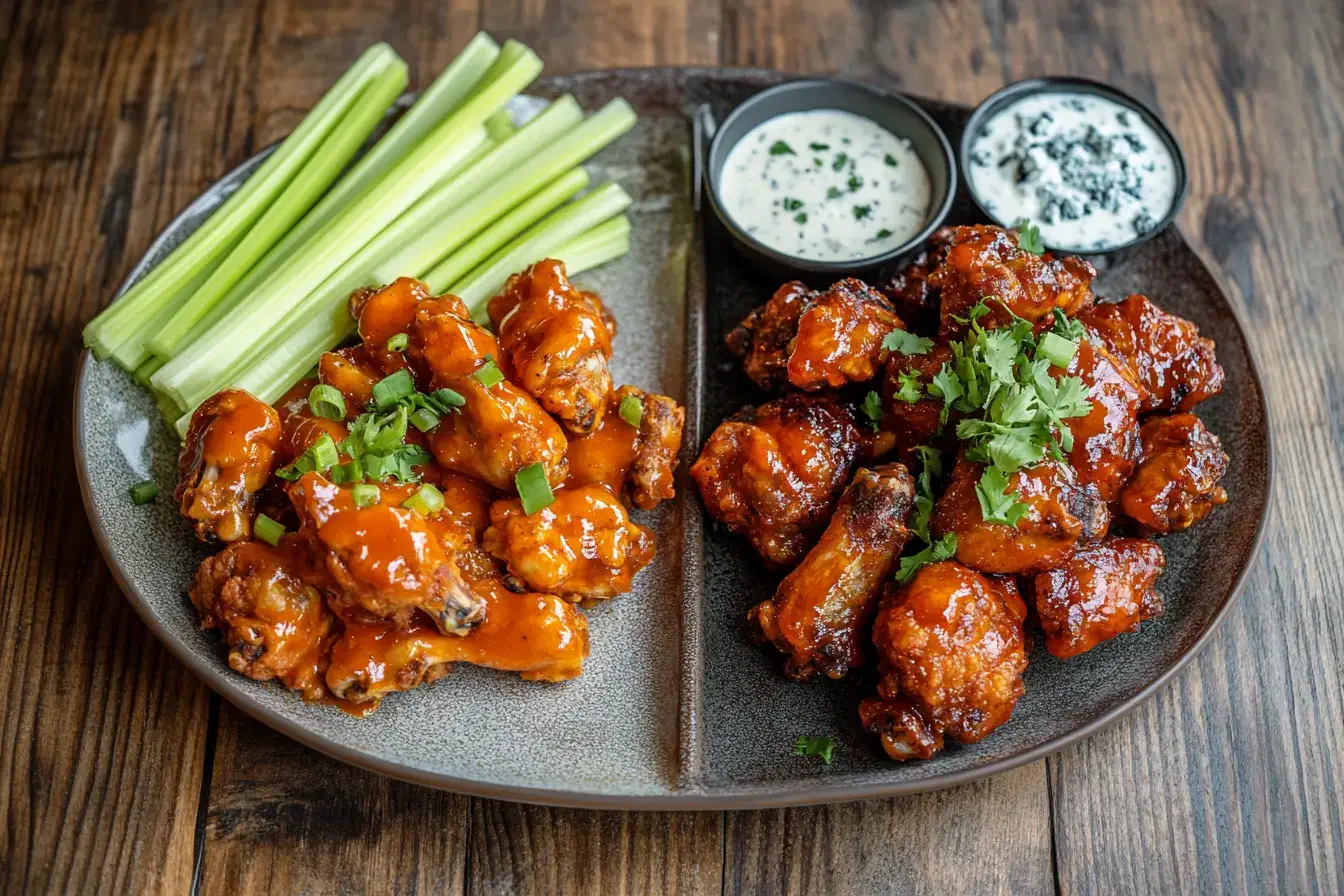Table of Contents
When it comes to finger-licking snacks, chicken wings are the MVP. But wait a second—are chicken wings the same as Buffalo wings? While they might seem similar on the surface, there’s a whole world of difference between the two. Let’s dive into this tasty debate and uncover what sets these winged treats apart!
“Chicken wings may look alike, but the secret lies in their preparation, flavor, and history.”
What’s the difference between chicken wings and buffalo wings?
What Are Chicken Wings?
Chicken wings are exactly what they sound like—the wings of a chicken. Typically, they come in three parts: the drumette (that little drumstick-looking piece), the wingette (the flat, middle section), and the tip. While the tips are often discarded or used for stock, the drumettes and wingettes are where the magic happens. These can be grilled, baked, or fried and served plain or with a variety of sauces and seasonings.
What Are Buffalo Wings?
Buffalo wings, on the other hand, are a specific type of chicken wing that hails from Buffalo, New York. They’re usually deep-fried until crispy, then tossed in a tangy, spicy sauce made from hot sauce and melted butter. Unlike plain chicken wings, Buffalo wings pack a punch that makes them a game-day favorite. Oh, and don’t forget the classic sides: celery sticks and blue cheese or ranch dressing!
The History Behind Chicken Wings and Buffalo Wings
Origins of Chicken Wings
Chicken wings have been enjoyed for centuries across various cuisines. In Asian cultures, wings are often marinated with soy sauce, ginger, and garlic, while in Southern American cooking, they’re breaded and fried to crispy perfection. Wings were typically seen as a byproduct of butchering, making them a humble but versatile option in the kitchen.
The Birth of Buffalo Wings
The story of Buffalo wings began in 1964 at Anchor Bar in Buffalo, New York. According to legend, co-owner Teressa Bellissimo whipped up a batch of wings tossed in hot sauce for her son and his friends as a late-night snack. They loved them, and soon, Buffalo wings became a menu staple, sparking a nationwide obsession.
Key Ingredients That Differentiate Chicken Wings and Buffalo Wings
Flavor Profiles: Mild vs. Spicy
Chicken wings are all about versatility. They can be mild, sweet, tangy, or smoky, depending on the seasoning or sauce. Buffalo wings, however, are synonymous with heat and tang. Their signature spicy kick comes from hot sauce, balanced by the richness of butter.
Sauces: The Defining Element of Buffalo Wings
The sauce is what truly sets Buffalo wings apart. The classic Buffalo sauce is a simple combination of hot sauce, butter, and a dash of vinegar. In contrast, chicken wings might be dressed in barbecue sauce, honey mustard, or even teriyaki glaze.
Cooking Techniques: Traditional and Modern Methods
Chicken wings can be grilled, smoked, baked, or air-fried for a healthier twist. Buffalo wings stick to tradition: deep-frying is the go-to method for achieving that crispy exterior that soaks up the sauce perfectly. Deep-fried indulgence or baked goodness—it’s your call!
Texture and Appearance: How to Spot the Difference
Crunch vs. Tenderness: A Breakdown
When you bite into a Buffalo wing, you’ll notice a crispy outer layer that contrasts with the juicy meat inside. Chicken wings, depending on the cooking method, can range from tender and fall-off-the-bone to delightfully crunchy.
Visual Cues: Shape, Size, and Color
Buffalo wings are often coated in a vibrant orange-red sauce, thanks to the hot sauce and butter combo. Plain chicken wings, on the other hand, might look golden brown (if fried) or caramelized (if grilled or baked). Spotting the difference can be as easy as looking at the plate! 👀
Nutritional Comparison: Chicken Wings vs. Buffalo Wings
| Component | Plain Chicken Wings (Per Wing) | Buffalo Wings (Per Wing) |
|---|---|---|
| Calories | 43 | 99 |
| Protein | 6g | 6g |
| Fat | 3g | 7g |
| Sodium | 22mg | 350mg |
Caloric Content and Protein Levels
Plain chicken wings are relatively low in calories and fat, making them a healthier option when grilled or baked. Buffalo wings, with their buttery sauce and frying process, pack more calories and fat per wing. However, both options are rich in protein, which is great for muscle repair and growth.
Impact of Sauces and Frying on Nutrition
Adding sauce and frying wings increases their sodium and fat content significantly. If you’re watching your diet, opt for baked wings with light seasoning or a homemade Buffalo sauce with less butter. Small tweaks can make a big difference!
Cultural Significance of Chicken Wings and Buffalo Wings
Popularity in American Cuisine
Chicken wings have become a staple in American cuisine, especially in bars and casual dining restaurants. Whether it’s game night or a family dinner, wings are a crowd-pleaser. Buffalo wings, in particular, hold a special place as the ultimate game-day snack.
Game Day and Party Food Favorites
Buffalo wings are practically synonymous with Super Bowl parties and sports events. Their bold flavor pairs perfectly with cold beer and competitive cheering. Chicken wings, with their wide flavor options, can be tailored to any occasion, making them equally popular at gatherings.
Common Misconceptions About Chicken Wings and Buffalo Wings
Are All Buffalo Wings Spicy?
Nope! While traditional Buffalo wings are spicy, many restaurants offer milder versions or even sweet Buffalo sauces. There’s a wing for every spice tolerance level.
Do Buffalo Wings Come from a Special Chicken?
Contrary to popular belief, Buffalo wings don’t come from a different type of chicken. They’re simply regular chicken wings prepared in a specific style. No unique chicken species involved here!
Cooking Chicken Wings vs. Buffalo Wings at Home

Recipes for Perfect Chicken Wings
For plain chicken wings, try seasoning them with salt, pepper, garlic powder, and paprika, then bake or grill until golden. Want something saucier? Toss them in barbecue sauce or a honey glaze after cooking.
Crafting Authentic Buffalo Wings
To make Buffalo wings, fry the wings until crispy, then coat them in a mixture of melted butter and your favorite hot sauce. Serve with celery sticks and blue cheese dressing for that classic touch. Pro tip: Adjust the sauce-to-butter ratio to suit your spice preference.
Best Pairings for Chicken Wings and Buffalo Wings
Dips, Drinks, and Sides
Both types of wings pair beautifully with dips like ranch, blue cheese, or honey mustard. Add sides like fries, onion rings, or a crisp salad for a full meal. Don’t forget the drinks—a soda for kids or a cold beer for adults does the trick!
Complementary Beverages for Different Flavors
Buffalo wings are best with tangy or sweet beverages like lemonade or ginger ale to balance the heat. Plain chicken wings can go with anything from iced tea to a fizzy cola. The pairing possibilities are endless!
Problems and Solutions in Making Wings
Avoiding Soggy Wings
One of the most common complaints about homemade wings is sogginess. No one wants a wing that’s limp and lacks crunch, right? The key to avoiding this is ensuring your wings are as dry as possible before cooking. Pat them dry with paper towels, and if you’re frying, make sure the oil is hot enough (around 375°F). For baking, use a wire rack over a baking sheet to allow air to circulate and crisp up the skin. And remember, overcrowding the pan or fryer is a recipe for disaster!
“A little patience and the right technique can turn soggy wings into crispy perfection!”
Achieving the Perfect Buffalo Sauce Consistency
Buffalo sauce that’s too thick can clump, while a watery sauce just slides off. The golden ratio? Equal parts melted butter and hot sauce. Whisk them together over low heat, and if you want a creamier texture, toss in a bit of cornstarch slurry or a spoonful of heavy cream. For extra flavor, add a splash of Worcestershire sauce or garlic powder. Trust me, this will elevate your sauce game.
FAQs About Chicken Wings and Buffalo Wings
Which Is Healthier: Chicken Wings or Buffalo Wings?
If health is your main concern, plain chicken wings are generally the better option. Baking or grilling reduces the fat content, and you can control the amount of seasoning. Buffalo wings, while flavorful, are often deep-fried and coated in a butter-based sauce, adding extra calories. Both options are protein-rich, so moderation is key!
Can You Make Buffalo Wings Without Hot Sauce?
Absolutely! While hot sauce is traditional, you can achieve a Buffalo-style flavor using spicy alternatives like chili paste or cayenne pepper mixed with butter. For a milder variation, try barbecue or honey-based sauces for a sweet twist.
What Is the Best Way to Reheat Chicken Wings?
The oven is your best bet! Preheat it to 375°F, place the wings on a wire rack over a baking sheet, and heat for 10-15 minutes. This restores the crispness without overcooking the meat. Air fryers also work wonders for reheating wings quickly.
Where Can I Find the Best Buffalo Wings Near Me?
Craving delicious Buffalo wings and wondering where to find the best ones near you? Check out this guide for top locations: Where to Find the Best Buffalo Wings Near Me Right Now. From local favorites to nationwide chains, this article has got you covered!
Do Buffalo Wings Come from a Special Chicken?
No, Buffalo wings come from regular chickens. The term “Buffalo” refers to their preparation style, originating from Buffalo, New York, not a unique breed of chicken!
Why Are Buffalo Wings Named After Buffalo?
They’re named after Buffalo, New York, where they were invented at Anchor Bar in 1964. It’s all about the city, not the animal!
Conclusion: A Tasty Debate That Keeps on Giving
So, there you have it—the juicy details on what makes chicken wings and Buffalo wings unique. Whether you prefer the classic crunch of plain chicken wings or the spicy, buttery goodness of Buffalo wings, one thing is for sure: wings are a universal favorite that bring people together. Whether it’s a family dinner, game night, or just a casual snack, wings have a way of turning any occasion into a feast.
“In the end, it’s not about choosing sides—it’s about savoring every bite!”

